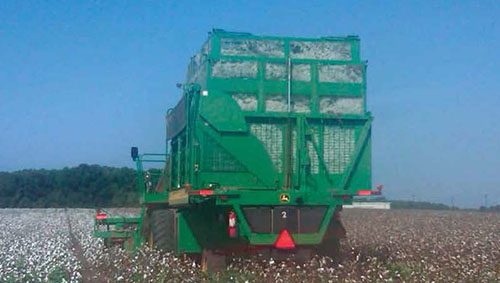 Squeezed by increasingly tight budgets, business-savvy airports of various types and sizes are turning to their land and its natural resources for additional streams of non-aeronautical revenue. Some earn surprisingly sizable returns by the bushel or acre.
Squeezed by increasingly tight budgets, business-savvy airports of various types and sizes are turning to their land and its natural resources for additional streams of non-aeronautical revenue. Some earn surprisingly sizable returns by the bushel or acre.
At Huntsville International Airport (HSV) in Alabama, rich soil well suited for cotton farming provides a steady supply of extra cash. Over the next 10 years, the airport expects to earn about $5 million by leasing land just beyond the reaches of its aviation activities to local farmers.
Since the airport was built, HSV has always had land available for industrial development. Leasing it for agricultural purposes instead was a "natural decision," because the airport was built on a former cotton plantation, explains Butch Roberts, deputy director of the Huntsville-Madison County Airport Authority.
 "We have evolved into a pretty large cotton farming operation here in Huntsville," reports Roberts.
"We have evolved into a pretty large cotton farming operation here in Huntsville," reports Roberts.
Under the airport authority's most recent contract, nearly 3,000 acres was leased at a rate of $206.25 per acre for the next 10 years.
The airport authority issued a formal request for proposals to select its agricultural partner, but limited bidding to farmers living within 50 miles of the airport, notes Roberts. "We treated it a lot like a concessions agreement or a rental car agreement, and we really pushed it," he recalls.
Given the crop history of the airport's property, the request for proposals garnered ample interest; and pure competition ultimately drove the deal. "We got out in front of it knowing we had a lot of interest," relates Roberts.
|
factsfigures Project: Agricultural Land Lease Location: Huntsville (AL) Int'l Airport Crop: Cotton Lease Rate: $206.25/acre Land Leased: Almost 3,000 acres Contract Length: 10 yrs. 2012 Revenue: $500,000 Total Contract Value: $5 million
Project: Timber/Pine Straw Production Location: Jacksonville Int'l Airport, Herlong Recreational Airport, Jacksonville Executive, Cecil Airport Timber Consultant: The Forestry Company Current Contract: 5 yrs., with a 5-year option Total Timberland: 1,260 acres Historic Revenues: $300,000/yr. Challenges: Volatility of wood market & lumber prices New Strategy: Reforestation program to speed renewal of timber
Project: Natural Gas Drilling Location: Pittsburgh Int'l Airport Timeline: To Be Determined Potential Revenue: $3,000 – $4,000/acre in annual land leases; $8 million – $13 million/year in ongoing royalties, depending on market price of gas Challenges: Fluctuating natural gas prices; reconciling revenue claims with sources of funding for original land purchases; securing FAA approval for drilling operations |
In the end, Darden Bridgeforth and Sons outbid the previous farmer's rate by 56%, garnering an additional $74.25 per acre for the airport authority.
"We are going from $300,000 last year to $500,000 this year," Roberts concludes. "On a consistent basis, cotton farming is among our top revenue generators."
Lumberjack Loot
In previous years, timber harvesting and pine straw production have earned the Jacksonville (FL) Aviation Authority roughly $300,000 annually, but revenue projections are a constantly moving target.
"There are no guarantees," explains Jacksonville Aviation Authority Properties Administrator Rolf Riechmann, noting that the wood market is extremely volatile. The authority receives earnings estimates when its timber consultant bids harvesting work out to logging companies, but the price remains uncertain until the wood reaches the paper mill, he explains.
Although timber and pine straw harvesting generate small amounts of revenue for the authority, Riechmann still considers it "good business."
As the authority's contract with a previous timber consultant expired, it issued a request for proposals in October 2010.
Ultimately, The Forestry Company won the five-year contract, with a five-year option. As such, it develops timber plans for each of the authority's four airports: Jacksonville International, Herlong Recreational, Jacksonville Executive and Cecil. In total, the agreement covers 1,260 acres of timberland.
The conservation area forest management plan created by The Forestry Company includes a timber inventory and harvest schedule. The company also manages the harvest – bidding out logging services and selling the timber. Jacksonville Aviation Authority collects the sale proceeds, less The Forestry Company's fees.
With a new timber consultant on board, the authority is engineering a new strategy to sustain the bountiful pines on its acreage. For the past 10 years, it was simply collecting profits from cuttings. Now, it's initiating a reforestation program.
"We will plow more of that money back into the land and replanting trees, so that 15 to 20 years from now we will have the income coming back again," Riechmann explains. "We are trying to be more proactive and socially responsible. I don't know that it will drive up revenue, but it will make us more sustainable."
Underground Revenue
There's no doubt that drilling for natural gas at Pittsburgh International Airport (PIT) will earn millions of dollars for the Allegheny County Airport Authority. But questions of optimum timing, ownership rights and the FAA's position on the process are still being sorted out.
When all the dust settles, authority officials expect the airport's gas-laden land to fetch $3,000 to $4,000 per acre in annual lease revenue, which would amount to $27 million to $36 million in upfront payments. In addition, landowners typically receive 18% to 20% in royalties from the sale of natural gas, which would bring in $8 million to $13 million per year, depending on the prevailing market price.
 "Because of the emergence of shale over the last few years, we realized we are sitting on very rich deposits of natural gas," explains Allegheny County Executive Rich Fitzgerald. "So we are looking at how we can best capitalize on that at the airport."
"Because of the emergence of shale over the last few years, we realized we are sitting on very rich deposits of natural gas," explains Allegheny County Executive Rich Fitzgerald. "So we are looking at how we can best capitalize on that at the airport."
Allegheny County is currently exploring options and consulting with experts in the market to determine the feasibility of drilling horizontally 5,000 to 8,000 feet underground.
 "We are looking at how FAA regulations regarding mineral rights work," Fitzgerald reports. "Locally, the airport authority, county council and county executive office are all in agreement that we would like to do a 50/50 split. Half of the money would go to help offset property tax, and the other 50 percent would be used to lower the cost and help development around the airport."
"We are looking at how FAA regulations regarding mineral rights work," Fitzgerald reports. "Locally, the airport authority, county council and county executive office are all in agreement that we would like to do a 50/50 split. Half of the money would go to help offset property tax, and the other 50 percent would be used to lower the cost and help development around the airport."
A mixed bag of funding for the original purchase of airport land considerably complicates the matter. "Sometimes the land was purchased using federal FAA dollars, and some of it was purchased locally and added to the airport property value," explains Fitzgerald. "If the land was purchased locally, can the local entity keep the money for their tax benefit? And if it was purchased by the federal government, should the FAA get those dollars?"
 Precedents at other airports, including Dallas/Fort Worth and Los Angeles International, may prove helpful, he notes.
Precedents at other airports, including Dallas/Fort Worth and Los Angeles International, may prove helpful, he notes.
The commodities market is also delaying the prospect of imminent drilling at PIT, notes Fitzgerald: "The natural gas market is at a pretty low point now, so I don't know that we would maximize our return either for the airport or our taxpayers, depending on how that split came about."
Other Options
 Natural gas, pine timber and cotton are just three examples of natural resources generating current and future revenue for airports. George Bush Intercontinental and Ellington Airport in Houston grow nearly 3,000 acres of hay varieties that is sold as feed for cattle and horses.
Natural gas, pine timber and cotton are just three examples of natural resources generating current and future revenue for airports. George Bush Intercontinental and Ellington Airport in Houston grow nearly 3,000 acres of hay varieties that is sold as feed for cattle and horses.
Solar energy is a valuable commodity at Fresno Yosemite International in California and numerous other airports throughout the country. In addition to using the sun's power to lower or eliminate electricity bills, some sell it. When the energy collected exceeds their own requirements, energy companies are willing to buy it.
Often an airport's cash drop is tied to the local economy or culture – cotton in Alabama or cattle feed in Texas, for instance. That means there are likely a variety of airport treasures still to be uncovered.





